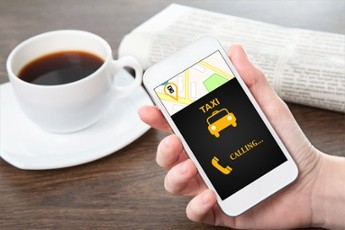
The North American taxicab industry has been a transportation staple for more than a hundred years. Taxicabs are a part of our pop culture and have been a trusted form of transportation from NYC to Anchorage. Movies have been produced with the taxi driver as a main character and passengers on a TV show can even win cash while sitting in the backseat of a cab. In the last few years, however, this traditional and celebrated industry has been influenced by an emerging disruptive technology – the smartphone app. Just as Apple upset a market, so have the apps running on its platform.
Attracting and retaining users is crucial in the app world. It is projected that there will be 225 million smartphones in the United States by the end of 2017. The sheer magnitude of the smartphone means that the power to dispatch has now extended to the passengers the very industry is focused on serving. Taxi apps are usually offered to passengers for free, and there are a lot of alternatives to choose from. Since the switching cost is so low, passengers can’t really be locked in. In addition, the app abandon rate is very high, and users are unlikely to re-download and re-try the apps that they purposely removed because of dissatisfaction or lack of use. In other words, to convince end-users to accept an app means that the app often has only one shot to impress.
Currently, there are hundreds of taxi-booking apps available. Regardless of the different features they offer, these apps all try to do one thing in common – mimic the user experience of conventional street hiring or telephone booking, and make it better. But many taxi-booking apps seem to have forgotten some basic common sense when booking and riding in a cab:
PEACE OF MIND
No one wants to get surprised when presented with the final bill. An app user who was recently charged $143 for a 5-mile ride on New Year’s night wrote on social media, “Hey <XYZ>, I Like Your Ride… But Not Sure It’s Worth The $143 You Charged Me.” Estimating a fair amount and sticking to it instead of sticking it to the customer can make all the difference.
EASY COMMUNICATION

Okay, you book a taxi from your app, and the app map shows your taxi is just around the corner, but 15 minutes later, the taxi hasn’t shown up. You can’t wait any longer and want to know what happened. You call the taxi company, but their phone line is busy. That’s when you realize that this is the reason why you booked your taxi using the app in the first place.
It’s of mutual benefit to both taxi companies and app users to have easy and direct communication between drivers and app users. For example, users can be notified if the trip is late, and given the option to continue to wait or to cancel the trip. Also, a user can send a message to the driver in case he can’t find his taxi that has actually arrived, and vice versa. This communication can significantly reduce no-shows and improve customer experience.
SECURE PAYMENT
Back to the radio dispatch age – if you pay for your taxi ride with a credit card (assuming it’s possible), your card number could be read over the radio, which broadcasts to perhaps 30 other active taxi vehicles as well as everyone inside. With advanced digital dispatch, security is improved because you only need to give your credit card to the driver. However, wouldn’t it be better if you could eliminate this step, and pay for your ride without disclosing your credit card information other via a secure transaction? It would be great if taxi apps could provide built-in secure payment processing.
 Frankly speaking, the essential criteria for an app to succeed is not only the number of its features but also its reliability. People tend to first complain about things that are promised but not delivered, and then look for things that are nice to have.
Frankly speaking, the essential criteria for an app to succeed is not only the number of its features but also its reliability. People tend to first complain about things that are promised but not delivered, and then look for things that are nice to have.
That being said, history tells us that a game changer does not usually come from the original industry but from substitute products. Twenty years ago, who could have imagined that the cell phone would kill the traditional camera industry? It’s difficult to predict what will ultimately reshape the taxi industry. But there’s one thing you can be sure of – with ever-faster technology evolution and consumer adoption of new services, the impact of any disruptive technology on a traditional industry will be significant and a force to be reckoned with.


